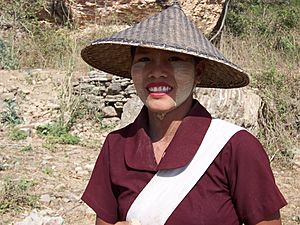Bamar facts for kids

Burmese woman in traditional clothing
|
|
| Total population | |
|---|---|
| c. 32 million | |
| Regions with significant populations | |
| ~30,110,000 | |
| ~2,890,000 | |
| 107,112 | |
| 72,368 | |
| 96,420 | |
| 15,800 | |
| 22,000 | |
| 66,500 | |
| 9,800 | |
| 7,300 | |
| 5,400 | |
| 4,700 | |
| Languages | |
| Burmese | |
| Religion | |
| Burmese folk religion and Theravada Buddhism | |
| Related ethnic groups | |
| Sino-Tibetan peoples | |
The Bamar (ဗမာလူမျိုး bama loo-myo) are the largest ethnic group in Myanmar. An ethnic group is a community of people who share a common culture, language, or history. The Bamar people are also called Burmese or Burmans. Most Bamar live around the Irrawaddy River in Myanmar. They speak the Burmese language, which is the official language of Myanmar.
Where do the Bamar people live?
The Bamar people originally came from Yunnan, a region in China. They moved to the Irrawaddy valley in Myanmar around the 7th century. Over many years, other groups like the Pyu joined the Bamar.
Scientists have studied the DNA of the Bamar people. These tests show that the Bamar are related to people from Southeast Asia and Northeast Asia. This means they share some family connections with people in those regions. They also have some influences from India.
What language do the Bamar speak?
The Bamar speak Burmese. This language belongs to a group called Sino-Tibetan languages. This means that some basic words in Burmese are similar to words in Chinese language and Tibetan language.
Many words in Burmese that are about Buddhism come from a language called Pali. Pali is an ancient language from India. The Burmese alphabet itself is also based on old Indian writing styles.
Images for kids
See also
 In Spanish: Birmania para niños
In Spanish: Birmania para niños



